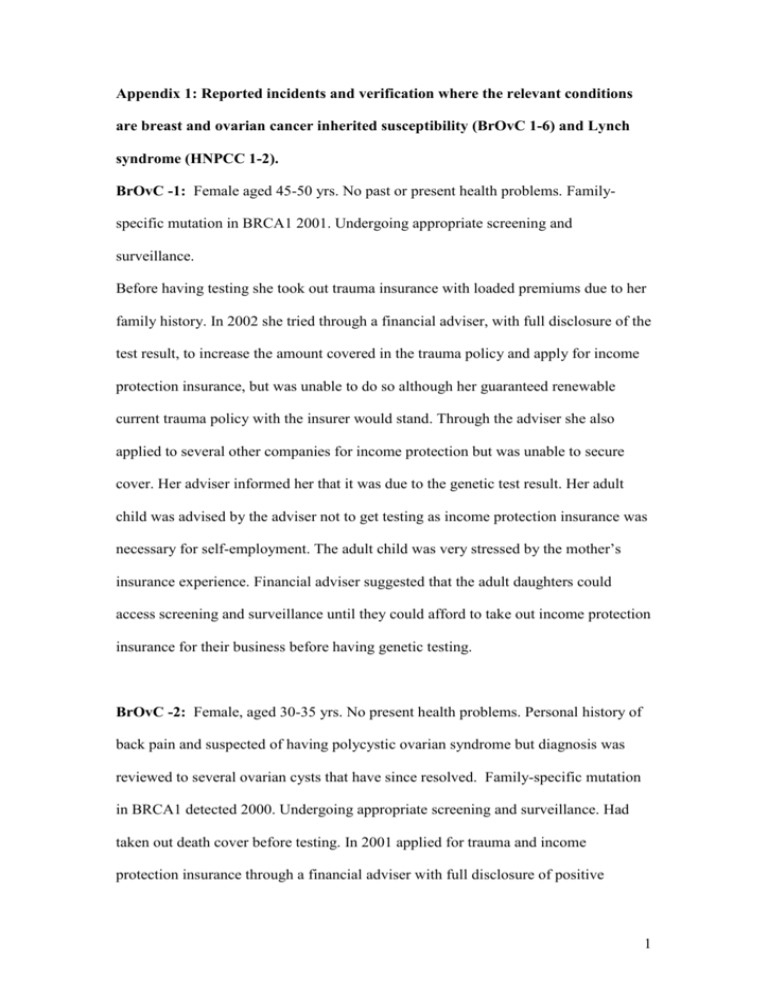Verification of consumers` experiences and perceptions of genetic
advertisement

Appendix 1: Reported incidents and verification where the relevant conditions are breast and ovarian cancer inherited susceptibility (BrOvC 1-6) and Lynch syndrome (HNPCC 1-2). BrOvC -1: Female aged 45-50 yrs. No past or present health problems. Familyspecific mutation in BRCA1 2001. Undergoing appropriate screening and surveillance. Before having testing she took out trauma insurance with loaded premiums due to her family history. In 2002 she tried through a financial adviser, with full disclosure of the test result, to increase the amount covered in the trauma policy and apply for income protection insurance, but was unable to do so although her guaranteed renewable current trauma policy with the insurer would stand. Through the adviser she also applied to several other companies for income protection but was unable to secure cover. Her adviser informed her that it was due to the genetic test result. Her adult child was advised by the adviser not to get testing as income protection insurance was necessary for self-employment. The adult child was very stressed by the mother’s insurance experience. Financial adviser suggested that the adult daughters could access screening and surveillance until they could afford to take out income protection insurance for their business before having genetic testing. BrOvC -2: Female, aged 30-35 yrs. No present health problems. Personal history of back pain and suspected of having polycystic ovarian syndrome but diagnosis was reviewed to several ovarian cysts that have since resolved. Family-specific mutation in BRCA1 detected 2000. Undergoing appropriate screening and surveillance. Had taken out death cover before testing. In 2001 applied for trauma and income protection insurance through a financial adviser with full disclosure of positive 1 BRCA1 test result and the suspected polycystic ovarian syndrome. Her financial adviser informed her that the senior underwriter was having a problem with the application. In 2002 the adviser informed her that the insurer would only offer her cover if any cancer was excluded – not just breast or ovarian cancer. She requested her adviser to appeal but was verbally informed by him that the decision would not be reversed and so she decided not to proceed, believing their response was unreasonable. She has since been successful in obtaining death, total and permanent disablement and income protection insurance at standard rates with another insurer. In that application, she disclosed her genetic test result and the fact that in her application to another insurer the decision was to offer cover with cancer exclusion which she declined. BrOvC -3: Male aged 30-35 yrs. No significant past or or current health problems. Family-specific mutation in BRCA2 detected 1998. Undergoing appropriate screening and surveillance. Insurer asserted that her financial adviser had been advised that the application had been denied rather than a policy offered with a total cancer exclusion clause. Current insurer confirmed that in her application to them for death, total and permanent disablement and income protection insurance (in place at standard rate) that she had stated that she had previously been offered a trauma and income protection insurance by the named insurer only with an exclusion cluse for all cancers due to her genetic test result. He applied through a financial adviser in 1998 to several companies for income protection insurance with full disclosure of his positive BRCA2 test result. All insurers declined or offered cover with very high loadings. In 2001 he took out sickness and accident insurance (a general insurance product), an annually renewable 2 policy providing income protection in case of a non-work related sickness or accident. In 2003, when renewing the policy, the underwriter noted his genetic test result and he was then unable to renew the income protection insurance in case of sickness and is covered for accidents only. The general insurer reviewed his risk assessment on previously disclosed information at the 3rd renewal date and stated that he was now covered for income protection in the event of an accident only and not for the onset of an due to his high risk for such an event. BrOvC -4: Male aged 45-50yrs. No past or present health problems. Family history of breast and ovarian cancer in female relatives. Family-specific mutation in BRCA2 detected 2002. Undergoing appropriate screening and surveillance for his small increased lifetime risk for prostate cancer. Applied through a financial adviser for trauma cover and income protection insurance in 2003 and was specifically asked if he had had any genetic testing. Application accepted with blanket exclusion of all forms of cancer. Appealed through adviser for against cancer exclusions but policy was offered with no change in terms. Reasons for the decision from chief medical officer were forwarded to his GP but the GP stated was that he was not given any specific information about the reasons for the exclusion and counselled that knowing about the mutation would have no impact on the applicant’s life so there was no benefit or disadvantage in knowing for himself. The insurer provided rationale for the decision made by the chief medical officer only relying on web-based information produced for life insurers 3 BrOvC -5: Female aged 30-35 yrs. No past or present health problems. Familyspecific mutation in BRCA1 detected 2003. Undergoing appropriate screening and surveillance. In 2002 she applied for income protection insurance through a financial adviser before she had genetic testing but disclosed her family history. The application took some time to process and during that time she had genetic testing and received her result. Her adviser encouraged her to inform her insurer of this new information as he thought it may change their underwriting decision (2003). She was informed by the adviser in a letter that she would be offered cover for income protection with the exclusion of all cancers. She told the adviser that she could understand the exclusion of breast cancer and would accept that non-standard decision but believed that the exclusion of all cancers was unfair and said that she would not accept the policy with these conditions. The adviser responded that he would appeal, requesting only breast cancer exclusion. A few weeks later the decision was reversed and she received a letter of offer from the insurer for income protection with exclusion only for breast cancer which she accepted. Financial adviser suggested that the adult daughters could access screening and surveillance until they could afford to take out income protection insurance for their business before having genetic testing. BrOvC -6: Female wishes to undertake predictive testing in 2006. Strong family history of breast and ovarian cancer. Prior to her death from cancer, the sister of the consumer had had limited genetic testing for BRCA1 and BRCA2 mutations some years previously. No mutation was found at that time. The consumer wanted access to her sister’s biopsy tissue for retesting for a mutation to determine if predictive genetic testing for herself and other 4 at-risk relatives would be possible . However, the sister had left instructions that “none of her biopsies be kept after her death, as she was worried about discrimination against her … descendents by insurance companies [and] employers”. The destruction of the samples has meant that mutation searching using wider searching techniques cannot be undertaken that may have enabled predictive testing for the family. Result is that mutation search using updated technology on the stored tissue to determine if a mutation is present in the BRCA1 or BRCA2 genes cannot be done that may have enabled predictive testing for at-risk relatives. HNPCC -1: Male aged 40-45 yrs. No past or present health problems. Familyspecific mutation for HNPCC detected 2001. Undergoing appropriate screening and surveillance. Had superannuation but he wanted additional life insurance cover. In 2002 applied for trauma, death and income protection insurance on advice of a financial adviser who applied on his behalf to several different companies with full disclosure. The financial adviser informed him that he could not get any insurance. The consumer accepted this advice and did not contact the insurers directly. Several insurance companies declined the policies, citing the genetic test result. HNPCC -2: Female, aged 30-35 yrs. No past or present health problems. Familyspecific mutation for HNPCC detected 1999. Preventive hysterectomy and oophorectomy 2000. Undergoing appropriate screening and surveillance. In 2000 she applied for Income protection with several companies through a financial adviser. Support letters were provided from her GP, oncologist and genetics health professional that stated that her risk of developing cancer were was less than normal. 5 Her adviser noted that no company was prepared to offer her the insurance. She was told by the adviser that the reason was that “the risk is too high” due to her genetic condition. The 1st company deferred the application until after the pending preventive hysterectomy and oophorectomy. After the surgery the 2nd company declined but noted that they also offered to reconsider this decision “on receipt of gastrointestinal history including information on gastritis and gastroscopy report” but there was no record of any further contact from the applicant. 6





